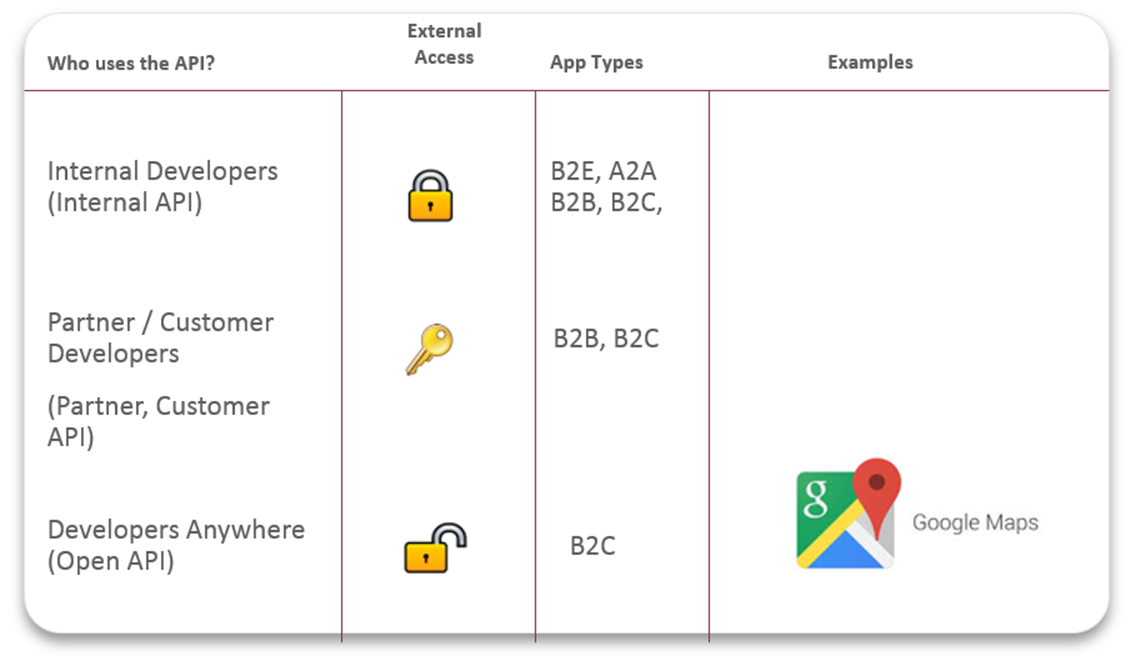
Depending on how you categorize them, APIs come in several different types, each with its own scope, benefits, and target audience. This makes them uniquely suited for different purposes.
API stands for Application Programming Interface. An API includes a collection of actions (or requests and responses) that developers can use. It also explains its functions, such as a “Save as” feature. Additionally, the API provides the necessary information for developers to structure these requests and responses properly.

It sounds complicated, but breaking all of it down can help. So, what are the different types of APIs available? Let’s take a look at how they differ.
Four Types of APIs by Audience
APIs come in various forms, giving developers the flexibility to choose the type that best suits their needs. One common way to categorize them is by their intended audience, which results in three primary categories: Open APIs, Partner APIs, and Internal APIs. Additionally, there is a bonus category, Composite APIs, which doesn’t neatly fit into any of these groups.
However, this isn’t the only way to categorize APIs. They can also be sorted by business use, industry vertical, technical type, or protocol/style (such as SOAP, REST, Async, GraphQL, etc.). Let’s start by looking at the types of APIs by audience.
YouTube link: https://youtu.be/DSHRDCQ8Vpw
Public APIs
Public APIs, also known as external or open APIs, are available to developers and other users with minimal restrictions. They may require registration, an API Key, or OAuth.
Some Public APIs are completely open. It’s important to note that while the terms “public” and “open” are often used interchangeably, not all public APIs are open. Furthermore, “Open API” and “OpenAPI” are distinct concepts.
When categorized by intended audience, public APIs are designed for external users to access data or services.

Public API Examples and Use Cases
The field of science often showcases a lot of free, open exchange of information via APIs. For instance, NASA’s open API portal allows developers to subscribe to its data, such as the popular Astronomy Picture of the Day API. Another API provides access to NASA technology project data in a machine-readable format.
Many contact tracing efforts during the Covid-19 pandemic also leveraged public APIs. Additionally, one country in the Asia Pacific uses APIs to enable fast, secure data-sharing, exemplifying how a single platform can support a mix of public, private (or internal/external), and partner APIs:
“The new data-sharing platform supports multiple data-sharing scenarios, including teams inside and outside the government. By opening up data to citizens and civic organizations through a public-facing API portal, the organization is leading the way in engaging and involving citizens in decision-making processes. Each use case has its own governance and security framework based on the audience and the type of data being shared.
For example, an API that enables data-sharing between multiple government agencies will have significantly more stringent and complex governance and security requirements than an API used by only one team in a single government department.”
Which leads us to the next type of API…
How Do Internal APIs Work?
Internal APIs, also known as private APIs, are concealed from external users and are only accessible by internal systems. These APIs are intended for use within the company, facilitating better productivity and reuse of services across internal development teams.
Nowadays, nearly every enterprise utilizes internal APIs. Many start by building an API on top of an internal database. A robust governance process includes exposing these APIs to an internal API developer portal connected to the internal IAM systems to authenticate and grant users access to the appropriate APIs.
The distinction between internal/external and private/public APIs can pose security challenges. This is why adopting a zero-trust approach—treating all APIs as if they could be exposed—is a more robust strategy for API security.
”Arun Dorairajan, Senior Solution Architect at Axway, notes that internal APIs tend to have a greater chance of being misconfigured inappropriately by internal teams. Threat defense cannot be limited to the enterprise’s perimeter: treat even internal APIs as if they were exposed externally, using rate limiting, throttling, and other methods to monitor their use.”
Beyond the security implications, this approach will also prepare your enterprise for the eventual external exposure of your APIs when it’s time to participate in a broader ecosystem.
Examples of Internal/Private APIs
Jeff Bezos set a precedent at Amazon with the API mandate, requiring that all capabilities be designed and exposed as APIs. Following this model, internal APIs enable different parts of an enterprise’s system to communicate and share data securely. Examples include:
- User Authentication APIs: These handle user logins and verify user identities within the company’s ecosystem, ensuring that only authorized personnel can access specific resources or perform certain actions.
- Data Retrieval APIs: These collect data from various databases or internal systems upon request. Similar to a librarian fetching specific books, these APIs pull the right data when needed, making it accessible for analysis or use in other applications.
- Workflow Automation APIs: These handle repetitive tasks or processes within the company’s workflow, such as automatically generating reports, scheduling tasks, or triggering actions based on certain conditions.
- Notification/Alerting APIs: These deliver real-time updates on system status, user actions, or other important events based on predefined triggers, keeping everyone informed.
For example, Robert W. Baird & Co., a Wisconsin-based investment bank and financial services company, uses APIs to provide ready access to their underlying data, delivering analytical insights to their customers.
“By improving the efficiency and effectiveness of our API development and management process, we’re cutting the time it takes from ideation to service deployment — helping us to bring value-added services to our customers faster than ever,” explains Jim Cornelius, Vice President, Solution Architect at Robert W. Baird & Co.
About DT Asia
DT Asia began in 2007 with a clear mission to build the market entry for various pioneering IT security solutions from the US, Europe and Israel.
Today, DT Asia is a regional, value-added distributor of cybersecurity solutions providing cutting-edge technologies to key government organisations and top private sector clients including global banks and Fortune 500 companies. We have offices and partners around the Asia Pacific to better understand the markets and deliver localised solutions.
How we help
If you need to know more about types of APIs, you’re in the right place, we’re here to help! DTA is Axway’s distributor, especially in Singapore and Asia, our technicians have deep experience on the product and relevant technologies you can always trust, we provide this product’s turnkey solutions, including consultation, deployment, and maintenance service.
Click here and here and here to know more: https://dtasiagroup.com/axway/










